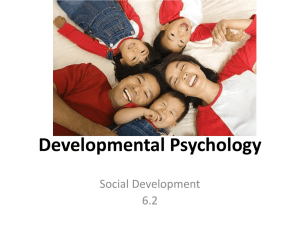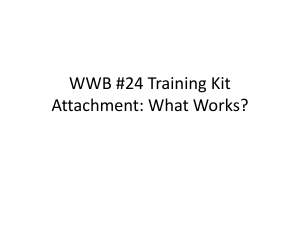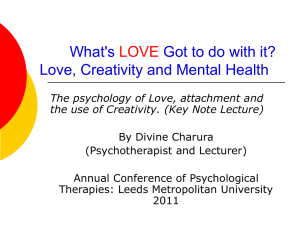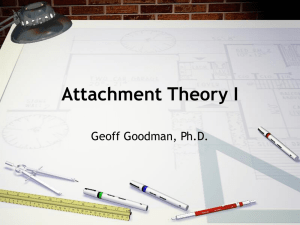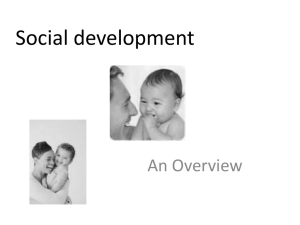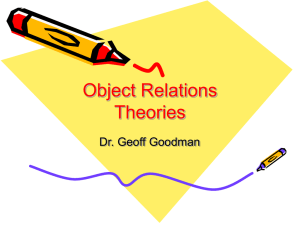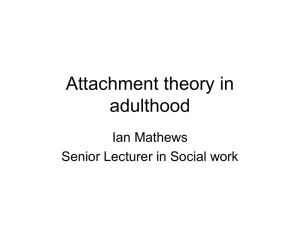Attachment Theory II
advertisement
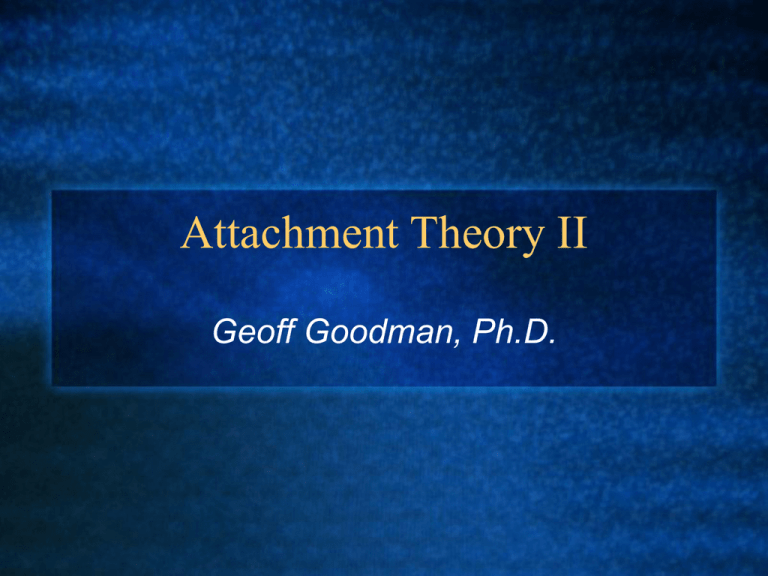
Attachment Theory II Geoff Goodman, Ph.D. I. Three Influential Attachment Theorist A. B. C. John Bowlby Mary Ainsworth Mary Main II. John Bowlby A. Internal working models (IWMs) 1. accurate representations of reality 2. expectations of caregiver behavior 3. nonenergic phenomena Continued… B. Defensive processes 1. defensive exclusion a. denial of the awareness of painful reality b. related to selective attention c. nonenergic phenomenon 2. cognitive disconnection a. displacement of attachment-- specific information onto another source b. nonenergic phenomena III. Mary Ainsworth A. Three attachment patterns 1. secure (B) 2. anxious- avoidant (A) 3. anxious- resistant (C) B. Development of Strange Situation 1. infants (12-18 months) 2. modified for older children (3-6 years) 3. stability of attachment a. 64% after 20 years b. 70% with no major life events IV. Mary Main A. Discovery of disorganized (D) attachment absence of strategy for managing attachment strategy (fight or flight, approach or avoidance conflict) 2. assigned along with a secondary organized category 3. associated with maternal psychopathology, abuse, unresolved loss prior to adulthood (frightened/ frightening behavior) 1. Continued… 4. assessment of attachment at level of mental representation a. Attachment Story- Completion Task (ASCT) 1) ages 3-9 2) responses to five story stems (spilled juice, hurt knee, monster in bedroom, departure, reunion) Continued… b. Adult Attachment Interview (AAI) 1) ages 13 and up 2) responses to 20 questions about relationships to parents between ages 5 and 12 3) same four attachment categories (F, Ds, E, U) Continued… c. Adult Attachment Projection (AAP) 1) ages 13 and up 2) responses to 8 ambiguously drawn, attachment-relevant pictures 3) same four attachment categories (F, Ds, E, U) Continued… d. Parental IWM of relationship with child 1) Parent Development Interview 2) Mother-To-Child Object Representation/ Internal Working Model Q-Sort (r =.90, p <.001) 3) Parental Caregiving Interview 4) The Working Model of the Child Interview (categorical) V. Comparison and Contrast Between Object Relations Theory and Attachment Theory A. Mental representations similar 1. cognitive- affective schemata 2. provide affectively charged information about object, self, and self-in-relation-to-object 3. internalization of episodic memories B. Gratification of endogenous needs 1. object representations-- libido and aggression 2. internal working models-- attachment needs (self- preservative drives from Freud) C. Accuracy of mental representations 1. IWMs-- accurate representations of reality that become distorted over time as infant accommodates reality of mother’s availability 2. object representations-- distortions of reality based on projection and introjection of infant’s own drive derivatives (e.g., temperament) D. Reliance on different kinds of casual inference 1. object relations theory-- retrospective data a. reconstruction of past b. false assumptions possible (e.g., D--> aggression) 2. attachment theory-- prospective data a. longitudinal observations over time b. less concerned with subjective experience c. acknowledgement of risk and protective factors E. Developmental model of psychopathology 1. stage theory a. humanity moves from psychopathology to mental health b. psychopathology-- fixation-- regression at earlier stage of development (e.g., psychosexual, separationindividuation) 2. developmental pathways (Bowlby’s)/ continuous construction (Zeanah) model a. deviance from mental health only for some persons b. psychopathology-- development continuously along its own pathway 3. accusations of each model as “static” a. b. c. object representation-- fixed at particular point in development internal working model--increasingly resistant to change (Bowlby) broad categories that fail to discriminate levels of adaptive functioning and development Continued… 4. floor effects of both models 5. distinction between quality of mental representations and level of adaptive functioning (e.g., Saddam Hussein, my child patient (.90)) 6. graphic differences between these two models a. unidimensional (quality, complexity, differentiation, integration) b. two-dimensional (security- anxiety, deactivating- hyperactivating) VI. New Model of Object Representations and IWMs A. Kernberg’s theory of personality organization 1. neurotic a. secure IWM b. integrated, differentiated object representation 2. borderline a. insecure IWM 1) preoccupied-- hyperactivating 2) dismissing-- deactiviating b. split-off, less differentiated object representation 3. psychotic a. unresolved IWM? 1) dissociative phenomena 2) disorientation b. undifferentiated object representations B. Application of Kernberg’s Theory to Structure of Internal Working Models 1. 2. developmental pathways model borderline personality organization a. with pathological grandiose self (NPD) b. without pathological grandiose self (BPD) c. unresolved category placed on preoccupied-hyperactivating end of continuum 3. preoccupied and dismissing individuals have similarly low conceptual level of object representation complexity C. Different levels of abstraction between object representations and internal working models



